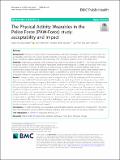The Physical Activity Wearables in the Police Force (PAW-Force) study : acceptability and impact
Abstract
Background: Policing is a highly stressful and increasingly sedentary occupation. The study aim was to assess the acceptability and impact of a mobile health (mHealth) technology intervention (Fitbit® activity monitor and ‘Bupa Boost’ smartphone app) to promote physical activity (PA) and reduce sedentary time in the police force. Methods: Single-group, pre-post, mixed methods pilot study. Police officers and staff (n = 180) were recruited from two police forces in South West England. Participants used the technology for 12 weeks (an ‘individual’ then ‘social’ phase) followed by 5 months of optional use. Data sources included Fitbit®-recorded objective step count, questionnaire surveys and semi-structured interviews (n = 32). Outcome assessment points were baseline (week 0), mid-intervention (week 6), post-intervention (week 12) and follow-up (month 8). Paired t-tests were used to investigate changes in quantitative outcomes. Qualitative analysis involved framework and thematic analysis. Results: Changes in mean daily step count were non-significant (p > 0.05), but self-reported PA increased in the short term (e.g. + 465.4 MET-minutes/week total PA baseline to week 12, p = 0.011) and longer term (e.g. + 420.5 MET-minutes/week moderate-to-vigorous PA baseline to month 8, p = 0.024). The greatest impact on behaviour was perceived by less active officers and staff. There were no significant changes in sedentary time; the qualitative findings highlighted the importance of context and external influences on behaviour. There were no statistically significant changes (all p-values > 0.05) in any secondary outcomes (physical and mental health-related quality of life, perceived stress and perceived productivity), with the exception of an improvement in mental health-related quality of life (SF-12 mental component score + 1.75 points, p = 0.020) from baseline to month 8. Engagement with and perceived acceptability of the intervention was high overall, but a small number of participants reported negative physical (skin irritation) and psychological (feelings of guilt and anxiety) consequences of technology use. Individual app features (such as goal-setting and self-monitoring) were generally preferred to social components (social comparison, competitions and support). Conclusions: mHealth technology is an acceptable and potentially impactful intervention for increasing PA in the police force. The intervention was less useful for reducing sedentary time and the impact on secondary outcomes is unclear.
Citation
Buckingham , S A , Morrissey , K , Williams , A J , Price , L & Harrison , J 2020 , ' The Physical Activity Wearables in the Police Force (PAW-Force) study : acceptability and impact ' , BMC Public Health , vol. 20 , 1645 . https://doi.org/10.1186/s12889-020-09776-1
Publication
BMC Public Health
Status
Peer reviewed
ISSN
1471-2458Type
Journal article
Description
Funding: SAB is supported by a PhD studentship from the University of Exeter Medical School and Devon and Cornwall Police.Collections
Items in the St Andrews Research Repository are protected by copyright, with all rights reserved, unless otherwise indicated.

